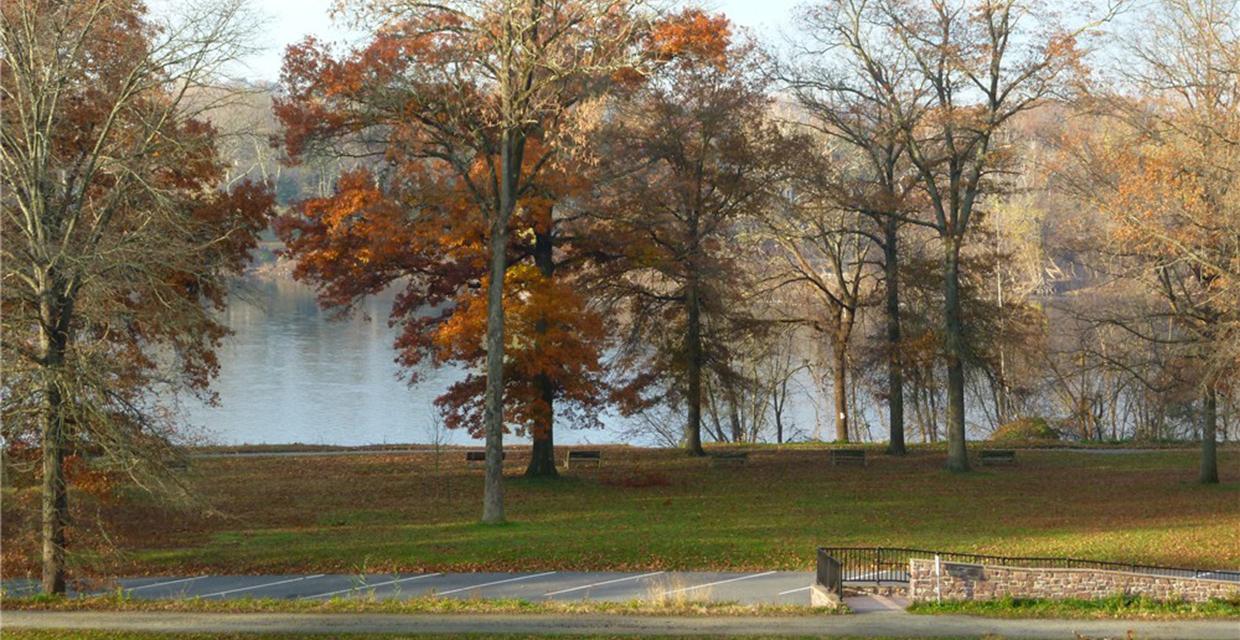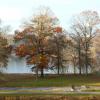Washington Crossing State Park


Park Overview:
This is the place out of the history books where the Continental Army crossed the Delaware River on Christmas night 1776.
Park Description:
Established in 1912, Washington Crossing State Park is the site where the Continental Army landed after crossing the Delaware River on Christmas night 1776. Within the 3,500-acre park are a 140-acre natural area containing fields in various stages of secondary succession and a mixed hardwood forest. In addition, the park includes a visitor center museum, the Johnson Ferry House, an observatory [open Friday nights seasonally] and a nature center, plus facilities for picnicking.
Trails Overview:
Originally preserved for its historical significance, the park is also well known for its trails and wildlife habitat. A wide variety of migrating birds use the stream and ravine as a resting place and for nesting. Many bird species winter in the park, creating a perfect location for bird observation year round.
With 15 miles of hiking trails there are plenty of places to walk in the park Use the Web Map link on this site for a trail map.
Click for detailed descriptions of hikes in the park.
Park Acreage:
3575.00 acresMunicipality:
TitusvilleThis is the place out of the history books where the Continental Army crossed the Delaware River on Christmas night 1776.
Established in 1912, Washington Crossing State Park is the site where the Continental Army landed after crossing the Delaware River on Christmas night 1776. Within the 3,500-acre park are a 140-acre natural area containing fields in various stages of secondary succession and a mixed hardwood forest. In addition, the park includes a visitor center museum, the Johnson Ferry House, an...
Park Acreage:
3575.00 acresMunicipality:
TitusvilleContact Information
Web Link:
NJ DEP, Division of Parks and ForestryPhone:
(609) 737-1517Fees:
Some times and places; check with parkDogs in park:
Dogs on leashHike Checklist:
Whether you are going for a day hike or backpacking overnight, it is good practice to carry what we call The Hiking Essentials. These essentials will help you enjoy your outing more and will provide basic safety gear if needed. There may also be more essentials, depending on the season and your needs.
The Essentials
Hiking Shoes or Boots
Water - Two quarts per person is recommended in every season. Keep in mind that fluid loss is heightened in winter as well as summer. Don't put yourself in the position of having to end your hike early because you have run out of water.
Map - Know where you are and where you are going. Many of our hiking areas feature interconnecting network of trails. Use a waterproof/tear-resistant Tyvek Trail Conference map if available or enclose your map in a Ziplock plastic bag. If you have a mobile device, download Avenza’s free PDF Maps app and grab some GPS-enhanced Trail Conference maps (a backup Tyvek or paper version of the map is good to have just in case your batteries die or you don't have service). Check out some map-reading basics here.
Food - Snacks/lunch will keep you going as you burn energy walking or climbing. Nuts, seeds, and chocolate are favorites on the trail.
Sunscreen and insect repellent
Rain Gear and Extra Clothing - Rain happens. So does cold. Be prepared for changing weather. Avoid cotton--it traps water against your skin and is slow to dry. If you are wearing wet cotton and must return to your starting point, you risk getting chills that may lead to a dangerous hypothermia. Choose synthetic shirts, sweaters and/or vests and dress in layers for easy on and off.
Compass - A simple compass is all you need to orient you and your map to magnetic north.
Light - A flashlight or small, lightweight headlamp will be welcome gear if you find yourself still on the trail when darkness falls. Check the batteries before you start out and have extras in your pack.
First Aid Kit - Keep it simple, compact, and weatherproof. Know how to use the basic components.
Firestarter and Matches - In an emergency, you may need to keep yourself or someone else warm until help arrives. A firestarter (this could be as simple as leftover birthday candles that are kept inside a waterproof container) and matches (again, make sure to keep them in a waterproof container) could save a life.
Knife or Multi-tool - You may need to cut a piece of moleskin to put over a blister, repair a piece of broken equipment, or solve some other unexpected problem.
Emergency Numbers - Know the emergency numbers for the area you're going to and realize that in many locations--especially mountainous ones, your phone will not get reception.
Common Sense - Pay attention to your environment, your energy, and the condition of your companions. Has the weather turned rainy? Is daylight fading? Did you drink all your water? Did your companion fail to bring rain gear? Are you getting tired? Keep in mind that until you turn around you are (typically) only half-way to completing your hike--you must still get back to where you started from! (Exceptions are loop hikes.)
Check the weather forecast before you head out. Know the rules and regulations of the area.
The Leave No Trace Seven Principles
Plan Ahead and Prepare
- Know the regulations and special concerns for the area you'll visit.
- Prepare for extreme weather, hazards, and emergencies.
- Schedule your trip to avoid times of high use.
- Visit in small groups when possible. Consider splitting larger groups into smaller groups.
- Repackage food to minimize waste.
- Use a map and compass to eliminate the use of marking paint, rock cairns or flagging.
Travel and Camp on Durable Surfaces
- Durable surfaces include established trails and campsites, rock, gravel, dry grasses or snow.
- Protect riparian areas by camping at least 200 feet from lakes and streams.
- Good campsites are found, not made. Altering a site is not necessary.
- In popular areas:
- Concentrate use on existing trails and campsites.
- Walk single file in the middle of the trail, even when wet or muddy.
- Keep campsites small. Focus activity in areas where vegetation is absent.
- In pristine areas:
- Disperse use to prevent the creation of campsites and trails.
- Avoid places where impacts are just beginning.
- Pack it in, pack it out. Inspect your campsite and rest areas for trash or spilled foods. Pack out all trash, leftover food and litter.
- Deposit solid human waste in catholes dug 6 to 8 inches deep, at least 200 feet from water, camp and trails. Cover and disguise the cathole when finished.
- Pack out toilet paper and hygiene products.
- To wash yourself or your dishes, carry water 200 feet away from streams or lakes and use small amounts of biodegradable soap. Scatter strained dishwater.
- Preserve the past: examine, but do not touch cultural or historic structures and artifacts.
- Leave rocks, plants and other natural objects as you find them.
- Avoid introducing or transporting non-native species.
- Do not build structures, furniture, or dig trenches.
- Campfires can cause lasting impacts to the backcountry. Use a lightweight stove for cooking and enjoy a candle lantern for light.
- Where fires are permitted, use established fire rings, fire pans, or mound fires.
- Keep fires small. Only use sticks from the ground that can be broken by hand.
- Burn all wood and coals to ash, put out campfires completely, then scatter cool ashes.
- Observe wildlife from a distance. Do not follow or approach them.
- Never feed animals. Feeding wildlife damages their health, alters natural behaviors, and exposes them to predators and other dangers.
- Protect wildlife and your food by storing rations and trash securely.
- Control pets at all times, or leave them at home.
- Avoid wildlife during sensitive times: mating, nesting, raising young, or winter.
Be Considerate of Other Visitors
- Respect other visitors and protect the quality of their experience.
- Be courteous. Yield to other users on the trail.
- Step to the downhill side of the trail when encountering pack stock.
- Take breaks and camp away from trails and other visitors.
- Let nature's sounds prevail. Avoid loud voices and noises.
The Trail Conference is a 2015 Leave No Trace partner.
(c) Leave No Trace Center for Outdoor Ethics: www.LNT.org.
Trip Reports
rate experienceNJDEP News Release, October 14, 2009
DEP PRESERVES SCENIC ACRES
ALONG THE
(09/P24)
“With its breathtaking beauty and spectacular views of the
The DEP’s Green Acres program purchased the Goat Hill Overlook property for
$4.5 million from Constructural Dynamics Inc. of
In addition to views of the
The Goat Hill Overlook acquisition is part of the Green Acres’ Crossroads of
the American Revolution land preservation initiative, which links Revolutionary
War sites across the state to help interpret
The DEP's Green Acres program purchases land to protect environmentally
sensitive open space, water resources and other significant natural and
historical areas. Land acquired by Green Acres becomes part of the statewide
system of parks and forests, wildlife management areas and natural areas. Green
Acres provides funding to county and municipal governments and nonprofit
organizations to acquire open space and parks in their communities.
Since its inception in 1961, the program has protected more than 640,000
acres of open space, in addition to funding the development of hundreds of
parks throughout



For those who wish a little background about the depiction of Washington's crossing the Delaware, here's an article from the New York Times, December 25, 2011, about a famous painting and an updated interpretation:
"There are few images as enduring in American history as the one of General George Washington standing tall, next to the Stars and Stripes, in a rowboat gliding past mini-icebergs as he leads his troops across the Delaware River on Christmas Day 1776 to start a surprise attack on Hessian forces during the Battle of Trenton.
In his 1851 portrait, “Washington Crossing the Delaware,” among the best-known of American paintings, the artist, Emanuel Leutze, did not shy away from imbuing the scene with a dose of glory, inspiration and heroism.
He also did not let the facts get in the way of his masterpiece — the original hangs at the Metropolitan Museum of Art.
The only thing wrong with this historical image is the history part, said Mort Künstler, as he recently put the finishing touches on his own version of Washington’s crossing. As it rested on an easel in Mr. Künstler’s studio on Long Island, the painting looked nothing like the Leutze version.
“I’m not knocking the original: it’s got great impact and Leutze did a heck of a job,” Mr. Künstler said. “I give Leutze higher marks for a good painting than for historical accuracy, but why can’t you have both?”"
The newstory continues by clicking here.